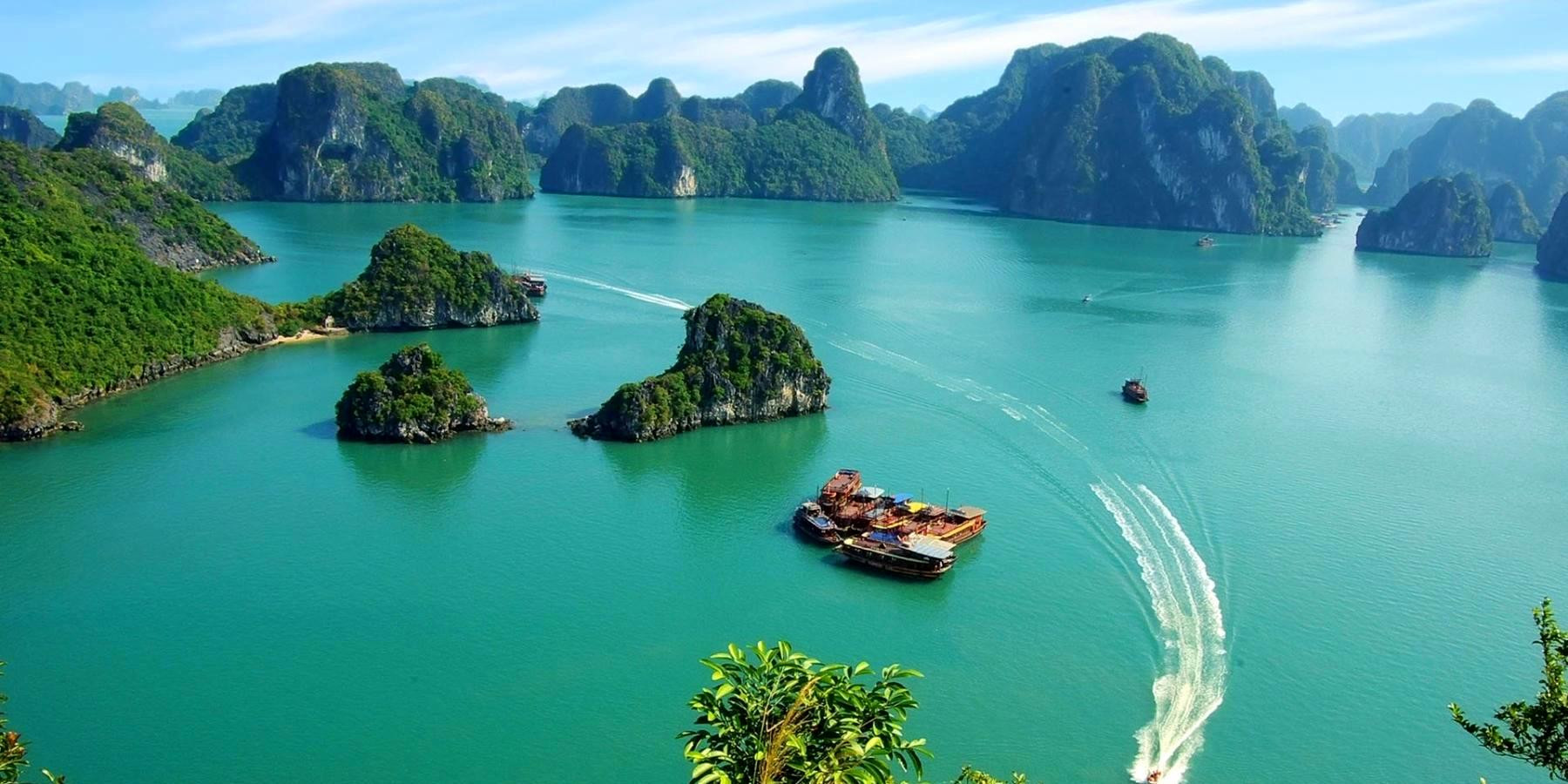Hanoi
Hanoi, the capital of Vietnam, offers a rich blend of history, culture, and modernity, making it a fascinating destination for any traveler. Here are some key aspects and attractions of Hanoi:

-
Historical and Cultural Significance: Hanoi has served as the political hub of Vietnam for over a thousand years, and much of its cultural heritage is well preserved. The city's history is displayed through its architecture, which is a mix of Southeast Asian, Chinese, and French influences. Notable historical sites include the Imperial Citadel of Thang Long, a UNESCO World Heritage Site that offers insight into Hanoi's complex history.
-
Vibrant Street Life: The heart of Hanoi's charm lies in its vibrant street life, especially in the bustling Old Quarter. This area features narrow streets where the hustle and bustle of local commerce thrives. It's famous for its "36 streets," each traditionally associated with different artisan guilds, like Silk Street and Silver Street.
-
Culinary Scene: Hanoi is renowned for its culinary scene, particularly its street food. Signature dishes include Pho (Vietnamese noodle soup), Banh Mi (Vietnamese sandwich), and Cafe Trứng (egg coffee), offering a taste of the local flavor that is both inexpensive and delicious. The city's coffee culture is also a highlight, with numerous quaint cafes dotting the cityscape.
-
Lakes and Parks: Hanoi is also known as the "city of lakes," with many scenic lakes and parks that provide a respite from the urban rush. Hoan Kiem Lake, located at the center of the city, is a peaceful area where locals and tourists alike can enjoy a leisurely stroll or a quiet moment by the water. The lake is a social hub, particularly during the early morning and late evenings when people come out to jog, practice Tai Chi, and socialize.
-
Museums and Temples: The city houses several museums that chronicle the rich history and culture of Vietnam. The Vietnam Museum of Ethnology and Ho Chi Minh Mausoleum are pivotal for understanding the national identity and the revolutionary past of Vietnam. Additionally, beautiful temples such as the Temple of Literature and Ngoc Son Temple offer spiritual insights and a peek into the local religious practices.
-
Shopping and Entertainment: For shoppers, Hanoi offers a range of markets and shopping areas where you can buy everything from souvenirs to luxury goods. Dong Xuan Market is the largest market in Hanoi, known for its wholesale goods. For more upscale shopping, the Trang Tien Plaza offers international brands.
In summary, Hanoi is a city that marries the old with the new. It provides a rich tapestry of cultural experiences, from historical sites and natural beauty to vibrant markets and delicious street food, making it an essential stop on any Vietnam itinerary.
Ha Long Bay
Ha Long Bay, located in northeastern Vietnam, is one of the most iconic and breathtaking destinations in the world. Known for its emerald waters and thousands of towering limestone islands topped with rainforests, Ha Long Bay is a UNESCO World Heritage site that attracts millions of visitors each year. Here are some key features and activities that make Ha Long Bay a must-visit location:
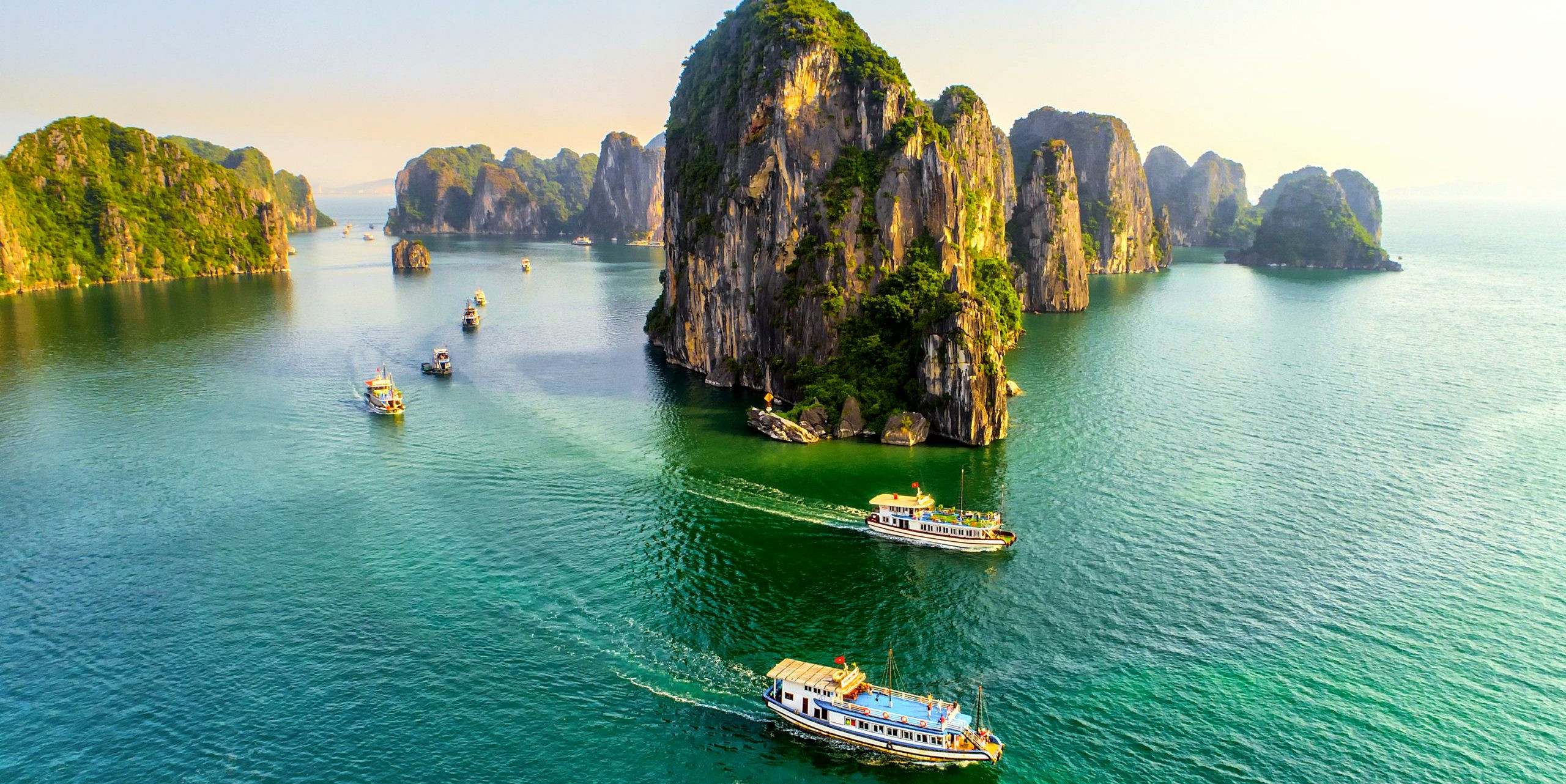
-
Stunning Natural Beauty: Ha Long Bay's most distinguishing features are its water and the more than 1,600 limestone karsts and isles in various shapes and sizes. This seascape creates a mystical atmosphere that seems almost surreal, especially in the misty morning light or during sunset.
-
Boat Cruises and Junk Boat Tours: Exploring Ha Long Bay is typically done aboard traditional wooden junk boats or modern cruise ships. These tours can vary from a few hours to several days, often including overnight stays on the water. Cruises offer a closer look at the detailed beauty of the bay’s geology, passing by islands named for their shapes, like Voi Islet (elephant) and Ga Choi Islet (fighting cock).
-
Adventure Activities: For the more adventurous, Ha Long Bay offers a range of activities. Kayaking and canoeing are popular ways to get up close to the islands and find hidden caves and secluded beaches. Some islands like Cat Ba, the largest island in the bay, are perfect for hiking, especially in the Cat Ba National Park which is home to diverse wildlife including the endangered Cat Ba langur.
-
Caves and Grottoes: The bay is also famous for its numerous caves and grottoes, each with its own unique beauty. Two of the most visited are Hang Sung Sot (Surprise Cave) and Hang Thien Cung (Heavenly Palace Cave), which are known for their stunning stalactites and stalagmites.
-
Floating Villages: Ha Long Bay is home to several floating villages where communities live and work on the water, maintaining a way of life that has endured for generations. Visiting these villages, such as Cua Van and Vung Vieng, offers insight into the locals' daily lives and the opportunity to support local crafts and fishing.
-
Local Cuisine: Seafood is a staple in Ha Long Bay, with fresh catches served daily. Dining on a boat while sampling local dishes like grilled squid, shrimp, and fish is an experience not to be missed. The culinary experiences here highlight the freshness and simplicity of Vietnamese coastal cooking.
-
Peace and Tranquility: Despite its popularity, there are moments and spots in Ha Long Bay where tranquility prevails, making it a perfect place for those seeking a serene getaway. Early morning tai chi sessions on the deck of a boat as the sun rises over the bay is a peaceful experience favored by many.
Ha Long Bay offers not just natural beauty but also a chance to engage in leisure and adventure activities. Its serene waters, towering limestone pillars, and rich biodiversity make it an unforgettable destination for any traveler visiting Vietnam. Whether you're cruising through the bay, exploring caves, or simply soaking in the stunning views, Ha Long Bay promises a truly majestic experience.
Hue
Hue, once the capital of Vietnam, is a city drenched in history and culture, making it a pivotal destination for anyone interested in Vietnam's imperial past. Situated on the banks of the Perfume River in Central Vietnam, Hue is best known for its historic monuments, which have earned it a place as a UNESCO World Heritage Site. Here’s what makes Hue a must-visit for travelers:
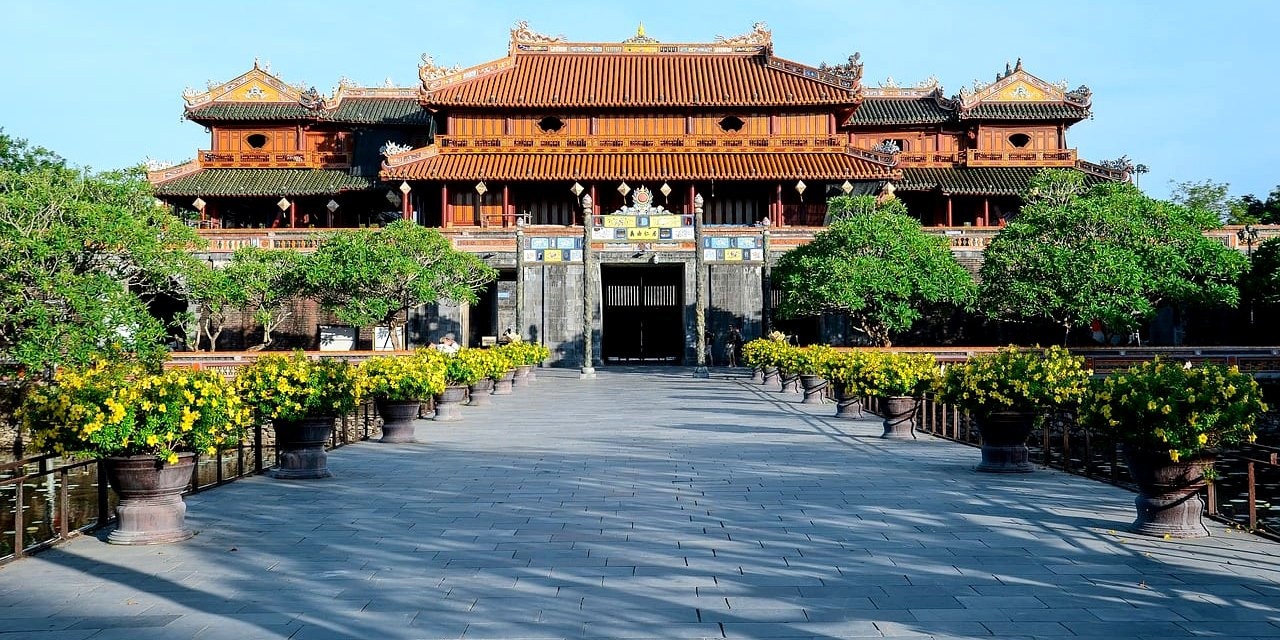
-
Imperial City: At the heart of Hue is the Imperial City, a vast complex protected by massive stone walls and surrounded by a moat. Inside, the Forbidden Purple City is a sanctum once reserved for the emperor and his family, resembling Beijing’s Forbidden City. Although much of the area was damaged during the Vietnam War, restoration efforts have been ongoing, and the architecture and detailed craftsmanship offer a glimpse into the past glory of Vietnam's imperial era.
-
Royal Tombs: Hue is also famous for its royal tombs, where the Nguyen Emperors are laid to rest. Each tomb reflects the personality and reign of the emperor it commemorates. Among the most visited are the Tomb of Tu Duc, with its serene lake and frangipani trees, and the Tomb of Khai Dinh, which stands out for its elaborate decoration and integration of Western and Eastern architectural styles.
-
Thien Mu Pagoda: The iconic Thien Mu Pagoda, with its seven-story tower, is perhaps the most famous religious site in Hue. Located overlooking the Perfume River, it features exquisite architectural details and is a key site for Buddhist worship.
-
Perfume River: A boat trip down the Perfume River is one of the best ways to see the city. These cruises typically pass by several of Hue’s famous landmarks and give a different perspective of the Imperial City and countryside. The river is named for the fragrant flowers that fall into the water from nearby orchards, especially in autumn when the flowers bloom.
-
Cuisine: Hue’s cuisine is distinct from the rest of Vietnam, known for its elegance and balance of flavor. Local specialties include bun bo Hue (a spicy beef noodle soup), banh khoai (Hue pancake), and various kinds of banh beo (steamed rice cakes), reflecting the royal influence on the city’s culinary traditions.
-
Cultural Festivals: Hue also hosts vibrant cultural festivals, most notably the Hue Festival, held every two years. It showcases a mix of local culture, music, performances, and international artists, attracting visitors and performers from around the world.
-
Local Crafts: Exploring Hue’s traditional crafts is another highlight. The city is known for its sophisticated ao dai tailoring and conical hats, which are considered among the best in Vietnam.
Hue offers a profound historical narrative that captures the imperial essence of Vietnam. Its well-preserved monuments, reflective river, and cultural richness make it a captivating place for history buffs, cultural enthusiasts, and casual travelers alike. Whether you're walking through the remnants of the Imperial City, cruising the gentle Perfume River, or savoring unique local dishes, Hue promises a memorable journey into the heart of Vietnam’s royal past.
Hoi An
Hoi An, a charming town in Vietnam, is renowned for its well-preserved Ancient Town, which is recognized as a UNESCO World Heritage site. Nestled on the central coast near the Thu Bon River, Hoi An is a picturesque example of a Southeast Asian trading port dating from the 15th to the 19th century. Its buildings and street plan reflect the influences, both indigenous and foreign, that have combined to produce this unique heritage site. Here's why Hoi An remains one of the top destinations in Vietnam:

-
Architectural Blend: Hoi An's architecture is a beautiful blend of styles, reflecting the indigenous and foreign influences that have shaped the town. Its historic architecture, traditional wooden houses, and hundreds of tailor shops create a distinctive atmosphere. The town's layout reflects its past as a trading hub, with tightly packed houses along narrow lanes.
-
Ancient Town: The heart of Hoi An is its Ancient Town, where visitors can wander through old wood-beamed houses converted into chic cafes and boutique shops. Highlights include the Japanese Covered Bridge and the colorful market. The town is particularly stunning at night when lanterns light up the streets, providing a magical and romantic feel.
-
Cultural Heritage: Hoi An is not just about aesthetics; it's also a place of rich cultural heritage. Visitors can explore numerous art galleries, museums, and theaters that offer insights into the history of the area and its complex cultural fabric. The town is also famous for its traditional music performances and festivals, particularly the Full Moon Lantern Festival, which transforms the town each month.
-
Culinary Delights: The food in Hoi An is as much a draw as its sights. The town is famous for dishes like Cao Lau (a type of noodle dish that is considered a delicacy), Banh Mi Hoi An, and Banh Bao Banh Vac (White Rose Dumplings). Street food tours and cooking classes are popular activities that offer deep dives into the local cuisine.
-
Tailor Shops: Hoi An is renowned worldwide for its tailoring industry. Visitors can have clothes custom-made at a fraction of what it would cost elsewhere. The town's skilled tailors can whip up everything from traditional Vietnamese garments to contemporary western outfits in just a few hours.
-
Scenic Surroundings: Outside of the town center, the countryside offers lush landscapes and tranquil settings. Cycling tours are a great way to explore the rice paddies and quiet beaches nearby. An Bang Beach is a popular spot for a day of relaxation under the sun.
-
Eco-Friendly Activities: Hoi An is also a leader in sustainable tourism in Vietnam. Many local businesses operate under eco-friendly principles, and there are numerous initiatives aimed at preserving the town’s unique heritage and environment.
Hoi An captivates visitors not only with its aesthetic and historical appeal but also through its cultural depth, vibrant culinary scene, and immersive experiences. Whether you're exploring its ancient streets, enjoying its gourmet offerings, or relaxing at the beach, Hoi An offers a memorable escape into Vietnam's past and present.
Da Nang
Da Nang, a dynamic city on the central coast of Vietnam, is known for its sandy beaches, scenic mountain landscapes, and modernist architecture. It serves as a gateway to several of Vietnam's cultural and natural sites, including Hoi An and the imperial city of Hue. Here’s what makes Da Nang a must-visit destination:
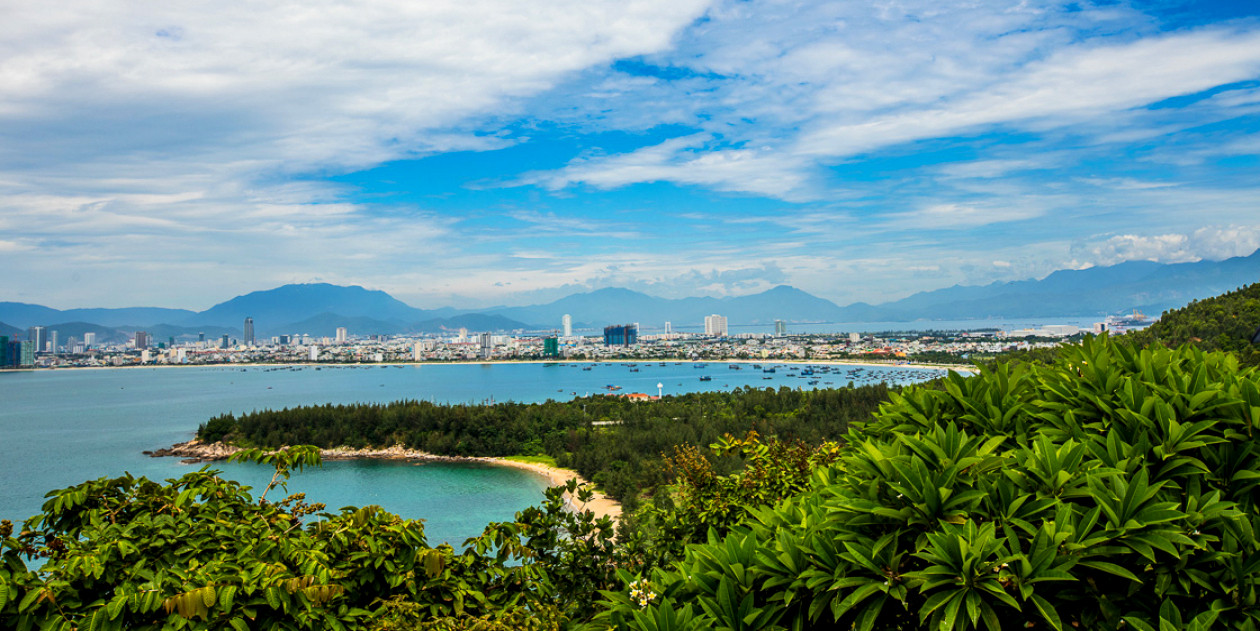
-
Stunning Beaches: Da Nang boasts some of Vietnam's most beautiful beaches, with My Khe Beach being the most famous. Praised by Forbes Magazine as one of the world's most attractive beaches, My Khe is renowned for its soft white sand, gentle slope, and year-round warm water. Other notable beaches include Non Nuoc and Bac My An, which offer ideal conditions for sunbathing, swimming, and surfing.
-
Marble Mountains: The Marble Mountains are a cluster of five hills made from limestone and marble. They are a well-known pilgrimage site with peaks, caves, tunnels, and temples all waiting to be explored. Each mountain is named after one of the five elements: Metal, Wood, Water, Fire, and Earth. The Water Mountain, with its intricate system of caves, is the most visited.
-
Modernist Architecture and the Dragon Bridge: Da Nang is also known for its modern architecture, including the Dragon Bridge, which spans the Han River. This bridge is an engineering marvel, designed in the shape of a dragon and brilliantly lit up at night. On weekends, the dragon breathes fire and water in a spectacular display that draws both locals and tourists.
-
Cultural Museums: The city is home to several museums that showcase its rich history and culture. The Museum of Cham Sculpture displays an extensive collection of Cham artifacts, while the Da Nang Museum gives insights into the region's past and its national heritage.
-
Son Tra Peninsula: The Son Tra Peninsula is a nature reserve and a must-see in Da Nang. It is home to the rare red-faced monkeys and offers panoramic views of the city and its surroundings, including a stunning view from the Linh Ung Pagoda, which features a giant statue of the Lady Buddha.
-
Food Scene: Da Nang’s culinary scene is as vibrant as its cityscape, featuring local specialties such as Mi Quang (Quang noodle), a turmeric-infused noodle dish typically served with shrimp or pork. The city’s street food culture is a delight for foodies, offering a mix of flavors from across Vietnam.
-
Festivals and Events: Da Nang hosts numerous festivals and events throughout the year, including the International Fireworks Festival, which draws teams from around the world. The city also celebrates traditional Vietnamese festivals with great enthusiasm, such as Tet (Vietnamese New Year) and the Mid-Autumn Festival.
Da Nang is a blend of natural beauty and cultural richness, offering everything from relaxing beaches and natural explorations to historical insights and vibrant nightlife. Its modern amenities and traditional Vietnamese elements make it a compelling stop for any traveler looking to experience the diversity of Vietnam. Whether you're exploring its landscapes, enjoying its culinary delights, or soaking in the culture, Da Nang offers a dynamic and enriching travel experience.
Nha Trang
Nha Trang, a coastal city and capital of Khánh Hòa Province on the South Central Coast of Vietnam, is famed for its stunning beaches, vibrant nightlife, and thrilling water sports. It's a popular destination for both domestic and international tourists, offering an ideal blend of relaxation and adventure. Here’s what makes Nha Trang a standout destination:

-
Pristine Beaches: Nha Trang is best known for its beautiful stretch of coastline with clear waters and sandy beaches, ideal for sunbathing, swimming, and snorkeling. The main beach, Nha Trang Beach, is a six-kilometer-long sandy beach right in the heart of the city, known for its crescent shape and bustling atmosphere. Nearby, Bai Dai Beach offers a more secluded and tranquil experience.
-
Water Sports and Activities: The city is a hub for water sports, particularly scuba diving and snorkeling, thanks to its abundant marine life and clear water conditions. Nha Trang Bay is considered one of the world's most beautiful bays, and the area is dotted with several islands, each providing a unique spot for water activities.
-
Vinpearl Land: Located on Hon Tre Island, Vinpearl Land is a resort island with an amusement park, water park, and a luxury resort. The island is accessible by cable car, which provides panoramic views of the bay. It's a popular destination for families and offers a variety of entertainment options from thrilling rides to water slides.
-
Po Nagar Cham Towers: These towers are an excellent example of Cham architecture, dating back to the 8th century. Dedicated to Yan Po Nagar, the goddess of the country, these brick Hindu temples are beautifully preserved and provide a historical counterpoint to the city's modern attractions.
-
Thap Ba Hot Springs: A trip to Nha Trang isn't complete without a visit to the Thap Ba Hot Springs, where visitors can enjoy mud baths and hot mineral soaking which are said to have therapeutic benefits. It’s a perfect relaxation activity after days of touring or beach activities.
-
Culinary Delights: Nha Trang’s food scene is heavily influenced by its coastal location, offering a wealth of seafood that is both fresh and affordable. Specialties include grilled squid, jellyfish salad, and fresh fish cooked in various styles. The city also has a vibrant nightlife with plenty of bars and restaurants along the beach to enjoy evening drinks.
-
Cultural Festivals: Nha Trang hosts the biennial Sea Festival, celebrating the beauty of the sea with events, games, and performances that attract tourists from all over. The festival highlights the local culture and the community's connection to the ocean.
Nha Trang seamlessly combines natural beauty with cultural richness, making it a versatile destination that caters to all types of travelers. Whether you're looking for a leisurely beach vacation, cultural exploration, or adventure-filled days, Nha Trang offers a compelling array of activities and attractions to create lasting memories.
Dalat
Dalat, nestled in the hills of Vietnam's Central Highlands, is known for its cool climate and scenic beauty, often referred to as the "City of Eternal Spring." The city's unique environment and charming architecture, a blend of French colonial influences and traditional Vietnamese design, make it a popular destination for both domestic and international tourists. Here's a closer look at what makes Dalat a special place to visit:
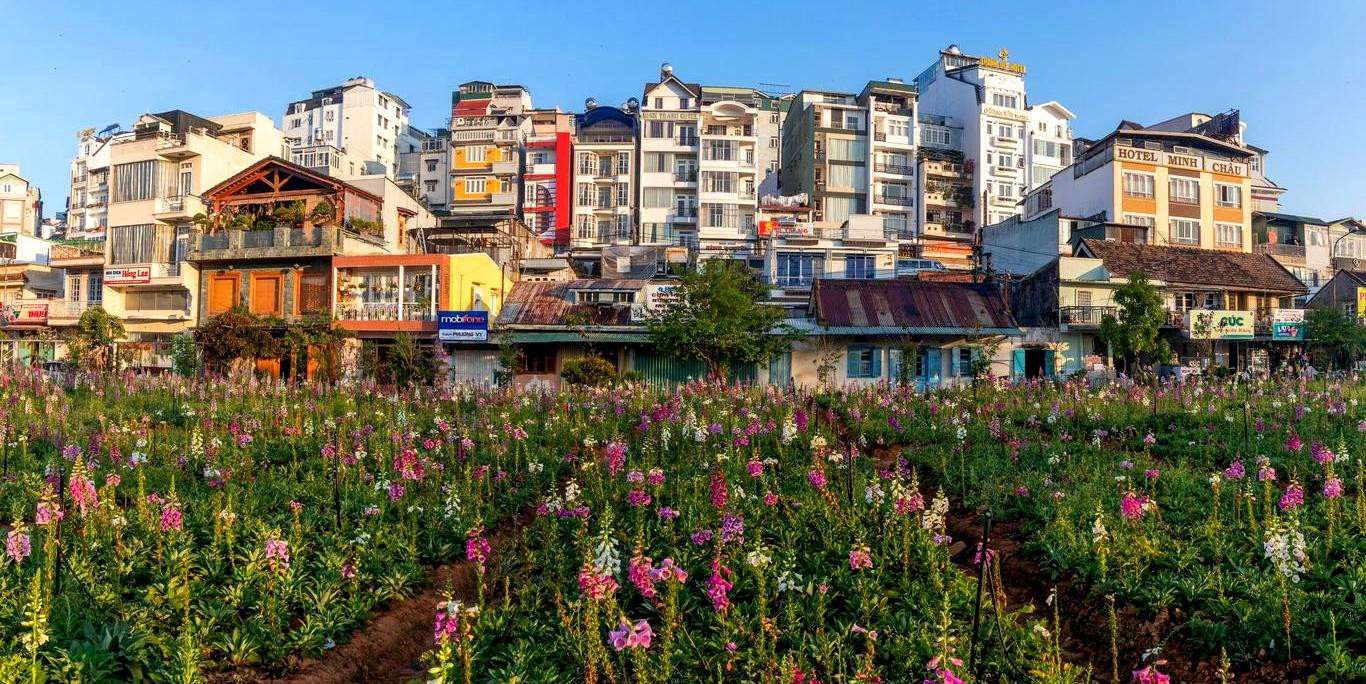
-
Cool Climate: Unlike the tropical climate dominant in most of Vietnam, Dalat enjoys a cooler, temperate weather year-round, which makes it a refreshing escape from the country's heat. This mild climate supports a lush landscape and the growth of unique flora such as hydrangeas, orchids, and roses.
-
Natural Scenery: Dalat is surrounded by nature, including lakes, waterfalls, evergreen forests, and gardens that are perfect for leisurely explorations and outdoor activities. The city is famous for its beautiful landscapes like Xuan Huong Lake, a serene body of water in the heart of Dalat, ideal for strolling and relaxing. Tuyen Lam Lake, surrounded by pine forests, offers boat rides and hiking trails. Additionally, the Elephant Falls and Datanla Falls provide picturesque spots for those looking for adventure.
-
French Colonial Heritage: The architecture of Dalat is markedly influenced by the French, who used the city as a vacation retreat from the heat of the rest of Vietnam. Landmarks like the Dalat Railway Station, designed in Art Deco style, and the Dalat Cathedral, with its distinctive spire, are examples of its colonial legacy. The city also boasts a variety of old villas and hotels that reflect this European influence.
-
Adventure Sports: Dalat is a hub for adventure sports, attracting thrill-seekers looking to partake in activities like mountain biking, trekking, and canyoning. The terrain and climate provide perfect conditions for such activities, making it an exciting destination for outdoor enthusiasts.
-
Local Markets and Cuisine: Dalat’s central market is a bustling hub where visitors can sample local specialties such as artichoke tea, strawberry jam, and fresh produce, including avocados, bananas, and the famous Dalat strawberries. The city is also known for its unique dishes like bánh tráng nướng (Vietnamese pizza made with rice paper as the base).
-
Flower Gardens: Reflecting its nickname, the City of Flowers, Dalat is famous for its flower gardens, with the Dalat Flower Gardens housing an impressive array of flowers spread over 7,000 square meters. The annual Dalat Flower Festival is a major event that attracts visitors eager to see the spectacular displays of flowers and ornamental plants.
-
Cultural Attractions: Beyond its scenic and culinary delights, Dalat offers cultural attractions such as the Crazy House (Hang Nga Guesthouse), an eccentric building that is part architectural wonder and part art gallery, inspired by the works of Gaudi and Dali.
Dalat’s combination of natural beauty, unique climate, and cultural richness makes it a standout destination in Vietnam. Whether you’re looking for relaxation, adventure, or a romantic getaway, Dalat offers a delightful and diverse experience away from the typical tourist paths.
Sa Pa
Sa Pa, located in the northern region of Vietnam in the Hoang Lien Son mountain range, near the Chinese border, is renowned for its stunning landscapes, rich cultural diversity, and vibrant hill tribe communities. Known primarily for its terraced rice fields, Sa Pa is a picturesque destination that offers a mix of natural beauty and cultural richness. Here’s why Sa Pa is a must-visit destination:

-
Majestic Mountain Scener: Sa Pa is dominated by Mount Fansipan, the highest peak in Indochina, standing at 3,147 meters above sea level. The mountain's presence offers spectacular scenery and a challenge for trekkers looking to summit the peak. The cable car to the top provides a less strenuous option with breathtaking views of the surrounding mountains and valleys.
-
Terraced Rice Fields: The terraced rice fields of Sa Pa are an iconic sight, cascading down the slopes of the Hoang Lien Mountains. These fields change color with the seasons, from lush green to golden yellow, offering stunning photographic opportunities. Trekking through these fields to explore nearby villages is a popular activity, providing insights into the agricultural practices that have shaped the landscape for centuries.
-
Ethnic Diversity: Sa Pa is home to several ethnic minority groups, including the Hmong, Tay, Red Dao, and others, each with their unique customs, traditions, and attire. The town's market is a hub of activity where these cultural exchanges are most visible. Visitors can learn about local lifestyles, enjoy traditional foods, and purchase handmade textiles and crafts, which are renowned for their intricate designs and techniques.
-
Trekking and Outdoor Activities: Sa Pa is a trekker's paradise, offering a variety of routes ranging from moderate walks to more challenging hikes through lush landscapes and mountainous terrain. Popular treks include routes to the villages of Cat Cat, Ta Van, and Ta Phin, where you can experience local hospitality and overnight homestays.
-
Cool Climate: Due to its high altitude, Sa Pa enjoys a cooler climate than much of Southeast Asia, which can be a welcome relief from the tropical heat. The weather can add to the mystic atmosphere, with fog and clouds often rolling through the hills and valleys.
-
Local Markets and Cuisine: The local markets in Sa Pa are vibrant and colorful, offering visitors a chance to engage with the local communities and their daily lives. These markets are not only places to buy goods but also social hubs where people gather to meet, exchange news, and socialize. The cuisine here is a reflection of its multicultural makeup, with dishes that are distinct from typical Vietnamese food, often featuring local herbs, vegetables, and meats.
-
Conservation Efforts and Eco-Tourism: Sa Pa has become a center for eco-tourism and conservation efforts, with initiatives aimed at preserving its unique biodiversity and promoting sustainable tourism practices. This focus ensures that visitors can enjoy Sa Pa's natural beauty while contributing to the preservation of the environment and the well-being of local communities.
Sa Pa offers a unique blend of breathtaking natural beauty, rich cultural diversity, and a range of outdoor activities that make it a standout destination for travelers looking to explore more than just Vietnam's urban environments. Whether you're an avid trekker, a culture enthusiast, or just looking to enjoy some of the most spectacular views Vietnam has to offer, Sa Pa is sure to provide an unforgettable experience.
Phu Quoc Island
Phu Quoc Island, often referred to as the "Pearl Island," is Vietnam's largest island and is situated in the Gulf of Thailand. Known for its white sandy beaches, crystal-clear waters, and lush tropical landscapes, Phu Quoc is rapidly becoming a top destination for travelers seeking both relaxation and adventure. Here are some highlights that make Phu Quoc a must-visit destination:
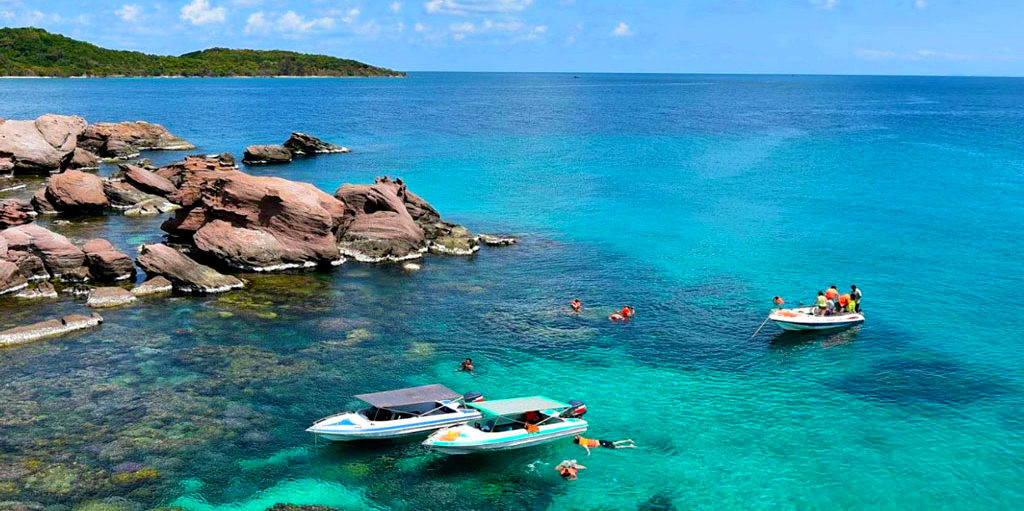
-
Stunning Beaches: Phu Quoc is ringed with some of the most beautiful beaches in Vietnam, such as Sao Beach, Long Beach, and Ong Lang Beach. These beaches are famous for their soft white sand and calm, turquoise waters, making them perfect for swimming, sunbathing, and a range of water sports.
-
Marine Life and Snorkeling: The waters around Phu Quoc are rich in marine life, offering excellent opportunities for snorkeling and scuba diving. The island is part of a larger marine park, which includes several smaller islands that serve as ideal spots for underwater exploration, with coral reefs and colorful fish in abundance.
-
National Park and Wildlife: More than half of Phu Quoc is designated as a national park, which includes dense tropical jungle, hiking trails, and mountains. This protected area is home to a variety of wildlife, including rare species such as the silver langur, slow loris, and hornbill. Trekking through the park, visitors can enjoy the lush greenery and perhaps catch a glimpse of some of the island's elusive wildlife.
-
Local Culture and Cuisine: Phu Quoc is also known for its unique culture, heavily influenced by the sea. The island is famous for producing some of the world's best fish sauce, a staple of Vietnamese cuisine. Visitors can tour the fish sauce factories to learn about this important culinary tradition. Additionally, the local night markets, such as Dinh Cau Night Market, offer a lively atmosphere where you can sample fresh seafood and traditional Vietnamese dishes.
-
Luxury Resorts and Accommodations: In recent years, Phu Quoc has seen significant development in terms of tourism infrastructure, with a range of accommodations from luxury resorts to more modest bungalows. Many of these resorts are located along the beachfront, providing guests with stunning sea views and direct beach access.
-
Relaxing and Wellness Experiences: Phu Quoc is an ideal destination for those looking to relax and rejuvenate. Many resorts offer spa treatments that incorporate local ingredients and traditions, providing a perfect way to unwind after a day of exploring the island.
-
Adventure Activities: For the more adventurous, Phu Quoc offers activities such as kayaking, jet skiing, and even cable car rides to Hon Thom Island, which boasts one of the world's longest overseas cable car systems. These activities provide thrilling ways to experience the island's natural beauty from different perspectives.
Phu Quoc Island combines tropical beaches, rich cultural experiences, and lush natural environments, making it a diverse and appealing destination for all types of travelers. Whether you're looking for a peaceful beach getaway, an eco-adventure, or a cultural exploration, Phu Quoc offers a little bit of everything under the warm Vietnamese sun.
Tips for Best Places to visit in Vietnam
Visiting Vietnam can be a thrilling experience, filled with diverse attractions ranging from bustling cities to serene landscapes. To make the most of your trip, here are some essential tips for visiting the best places in Vietnam:
-
Plan According to the Weather: Vietnam's climate varies significantly from north to south. The north has four seasons, while the south has a tropical climate. Plan your visit according to the weather conditions; for example, the best time to visit northern Vietnam is from October to April, and southern Vietnam from December to April to avoid monsoon seasons.
-
Embrace Local Transportation: To truly experience Vietnam, try local modes of transport. The motorbike is a popular choice and gives you flexibility in your travels. For longer distances, consider overnight trains or budget airlines.
-
Explore Beyond Big Cities: While cities like Hanoi and Ho Chi Minh City are must-visits, don't miss out on the charm of smaller towns like Hoi An, Hue, and Dalat. Each offers unique insights into Vietnam's rich history and culture.
-
Be Adventurous with Food: Vietnamese cuisine is varied and flavorful. Don’t hesitate to try street food, which is not only delicious but also a big part of Vietnamese culture. Dishes like Pho, Banh Mi, and local snacks like spring rolls should be on your list.
-
Learn Basic Vietnamese Phrases: Knowing a few basic phrases in Vietnamese can go a long way in enhancing your travel experience. Simple greetings, thank you, and numbers can help you navigate markets and restaurants more effectively.
-
Respect Local Customs and Etiquette: Vietnam is a culturally rich country with strong traditions. Dress modestly when visiting religious sites, and be sure to remove your shoes when entering someone's home or a temple.
-
Bargain Respectfully: Bargaining is common in Vietnamese markets, but it's important to do it respectfully. Start at around 50% of the asking price and work your way up from there, but keep it friendly.
-
Stay Connected: Purchase a local SIM card to stay connected and navigate easily. They are inexpensive and widely available in cities.
-
Stay Healthy: Drink bottled or filtered water, and be cautious with fresh juices and salads that may be washed in untreated water. Also, remember to bring insect repellent and sunscreen, especially when visiting rural areas or beaches.
-
Responsible Tourism: Be conscious of the environment and local communities. Avoid plastic usage, respect wildlife and natural habitats, and support local businesses by purchasing local products.
-
Safety First: While Vietnam is generally safe for tourists, it's always best to keep your belongings secure and be cautious of your surroundings, especially in crowded places.
Following these tips will help you have a smoother and more enriching experience as you explore the stunning landscapes and cultural richness of Vietnam. Whether it's the vibrant street life, the peaceful countryside, or the pristine beaches, Vietnam has a lot to offer every traveler.
Vietnam is a captivating blend of beautiful landscapes, rich history, and vibrant culture, offering something for every traveler. From the bustling streets of Hanoi to the tranquil Ha Long Bay and the historic charms of Hue to the serene beaches of Phu Quoc, Vietnam promises diverse experiences wrapped in breathtaking scenery and deep cultural richness. Embrace the local customs, explore beyond the tourist trails, and immerse yourself in the unique stories of each destination. Whether seeking adventure, culinary delights, or peaceful retreats, Vietnam is sure to deliver an unforgettable journey.
FAQs for Best Places to visit in Vietnam
Q: What is the best time to visit Vietnam?
A: The best time to visit Vietnam varies by region due to its elongated shape. Generally, the best months are from October to April for the north and central regions to avoid the rainy season and from December to April for the south.
Q: Do I need a visa to visit Vietnam?
A: Most visitors will need a visa to enter Vietnam. Some countries are eligible for a visa exemption for short stays. It’s advisable to check the latest requirements with the nearest Vietnamese embassy or the official immigration website.
Q: What are the must-visit cities in Vietnam?
A: Hanoi, the cultural and historical capital, Ho Chi Minh City for its dynamic atmosphere and modern attractions, and Hoi An for its preserved ancient architecture are must-visits. Hue and Dalat are also highly recommended for their unique cultural and historical significance.
Q: Is it safe to travel in Vietnam?
A: Vietnam is generally safe for travelers. Common sense precautions should be taken, especially in crowded tourist areas to guard against pickpocketing and petty theft.
Q: What should I pack for a trip to Vietnam?
A: Pack lightweight and breathable clothing, a good pair of walking shoes, rain gear, broad-spectrum sunscreen, mosquito repellent, and any necessary medications. For temple visits, ensure you have modest clothing that covers shoulders and knees.
Q: Can I use my credit cards in Vietnam?
A: Credit cards are widely accepted in major cities and tourist destinations but less so in rural areas. It’s advisable to carry some cash for small purchases, especially in local markets.
Q: What are the best souvenirs to bring back from Vietnam?
A: Popular souvenirs include Vietnamese silk, lacquerware, coffee, tea, spices, and handicrafts made by local ethnic groups.
Q: What are some traditional foods I should try in Vietnam?
A: Try Pho (noodle soup), Banh Mi (Vietnamese sandwich), Goi Cuon (spring rolls), and Bun Cha (grilled pork with noodles).
Q: Are there any health concerns I should be aware of?
A: Visitors should be up-to-date on routine vaccines, with some travelers considering hepatitis A, typhoid, and Japanese encephalitis vaccines based on their itinerary. Drinking bottled water and avoiding raw foods are recommended to avoid stomach illnesses.
Q: What language is spoken in Vietnam? Is English widely spoken?
A: Vietnamese is the official language. English is increasingly spoken by younger Vietnamese and in tourist areas, but learning a few basic Vietnamese phrases can enhance your experience.
For the Nepal tour, please click here.
If you are looking for different kinds of Nepal Tours or Trekking Packages, feel free to contact us.
